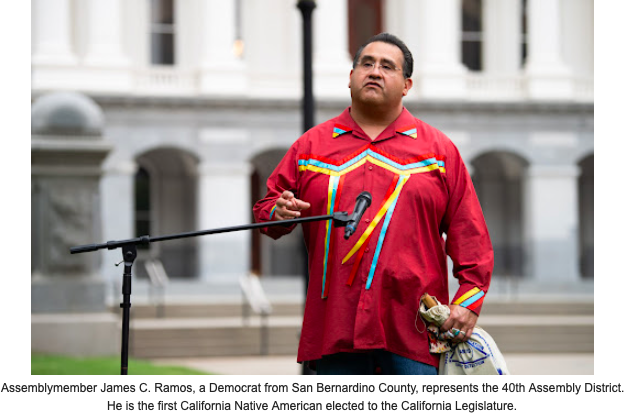Assembly Bill 1554, the California Indian Education Act was introduced on February 19, 2021 by Assemblymember James Ramos. Ramos is the first California Indian elected to the state Assembly. He is also a lifelong resident of the San Manuel Indian Reservation and a member of the Serrano/ Cahuilla tribes. Ramos is also the immediate past Chairman of the San Manuel Band of Indians. It has been his mission throughout his political career to promote and preserve California Indian Culture. So, it should come as no surprise that he brings forth the California Indian Education Act, which ensures that the history and culture of California Indians is taught in schools.
We undoubtedly need this. If we don’t take time to learn from true historical accounts and stories of California Native Americans, we will never understand the journey of these communities. California Native Americans were the first people of the land we currently live on and it’s important for us to understand how the government committed atrocities against them and how they were not only mistreated but massacred. Clearly, recent events have shown that there is a continued willful ignorance towards Indian culture that can only be addressed by teaching students the truth about these communities
The California Indian Education Act would include historically accurate accounts of California Indians in California history curriculum. The bill reads in part:
(4) Pupils are not taught historical accounts of Native American tribes and their interactions with the United States Government, including treaties, genocide, enslavement, the Indian Removal Act (1830), American Indian Urban Relocation, and other historical incidents. Few Californians are aware of the call by California’s first Governor, who put a bounty on the heads of Native Americans and called for their extermination. The Governor also funded militias and offered bounties by the state to fulfill that order.
(5) One historical incident not taught in state classrooms is the massacre of Pomo Indians in 1850 near Clear Lake. The massacre was carried out by a regiment of the United States Cavalry. This would later be called the Bloody Island Massacre, a government-sanctioned effort to exterminate Native Americans from California.
(6) It is critical that the state address the incomplete and inaccurate teaching of California Native American history. There should be thoughtful and comprehensive instructional standards that include education about the Native American people of the State of California, ensuring that history and social science instruction reflect the state’s true history.
Ramos recently penned an article for Cal Matters, where he explains some of his personal experiences growing up with education related to Native people.
“When I was a child in school, one teacher asked Native students to explain an Indian drum song. We replied we couldn’t because it was not part of the Serrano or Cahuilla culture, the tribes to which my classmates and I belonged. She told us to sit down because we must not be Indian enough. It was one of my first, but not last, classroom experiences with ignorance about Native people.” James Ramos
Present-day incidents that show why we need the California Indian Education Act include the following, per Ramos.
“Such education would also help prevent incidents such as the Riverside math teacher who recently wore a fake Indian headdress and thoughtlessly hopped around her classroom to teach trigonometry principles. The lack of respect behind that episode underscores the need to do a better job of incorporating Native American studies so the history of all Californians is taught and learned. Our teachers need more tools to perform their jobs, and we must demand more of our teacher training programs.”
Comadres, why are we not already teaching our children the truth about California’s history? Our students deserve to learn accurate history, one which tells the truth about Native people and communities of color. We will be following this bill and providing updates.
Latest posts by La Comadre (see all)
- Cómo está Regresando la Escuela de un Salón - July 28, 2022
- ¿Se Debe Exigir a los Estudiantes recitar el Juramento a la Bandera? - June 10, 2022
- 5 Aplicaciones de Salud Mental y Bienestar para descargar ahora Mismo - May 5, 2022
- How the One Room Schoolhouse Is Making a Comeback - May 5, 2022
- El Dinero Importa: Donación de $ 1 millón a Programas de Educación Financiera en LAUSD - April 25, 2022

